
Lake Minnetonka is a lake located about 16 miles (26 km) west-southwest of Minneapolis, Minnesota. Lake Minnetonka has about 23 named bays and areas. The lake lies within Hennepin and Carver counties and is surrounded by 13 incorporated municipalities. At 14,528 acres (5,879 ha), it is Minnesota's ninth largest lake. It is a popular spot for local boaters, sailors, and fishermen.
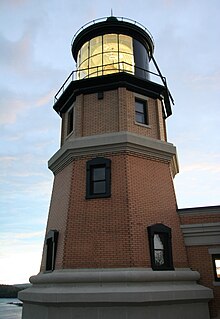
Split Rock Lighthouse is a lighthouse located southwest of Silver Bay, Minnesota, USA on the North Shore of Lake Superior. The structure was designed by lighthouse engineer Ralph Russell Tinkham and was completed in 1910 by the United States Lighthouse Service at a cost of $75,000, including the buildings and the land. It is considered one of the most picturesque lighthouses in the United States.
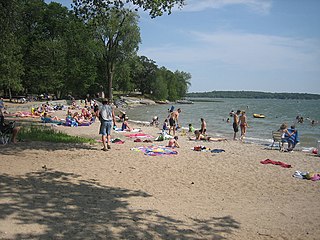
Sibley State Park is a Minnesota state park near New London, on the shores of Lake Andrew. It is named for Henry Hastings Sibley, the first governor of the state. A city park in Mankato, Minnesota is also named for Sibley.
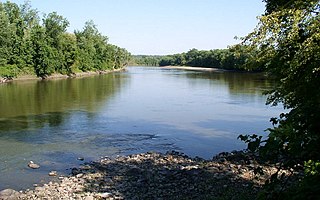
Traverse des Sioux is a historic site in the U.S. state of Minnesota. Once part of a pre-industrial trade route, it is preserved to commemorate that route, a busy river crossing on it, and a nineteenth-century settlement, trading post, and mission at that crossing place. It was a transshipment point for pelts in fur trading days, and the namesake for an important United States treaty that forced the Dakota people to cede part of their homeland and opened up much of southern Minnesota to European-American settlement.

The Charles P. Noyes Cottage was a summer home of Saint Paul pharmacist, Charles P. Noyes, who came to St. Paul in 1868. The cottage is listed on the National Register of Historic Places.

Samuel P. Ely is a shipwreck in Two Harbors, Minnesota listed on the National Register of Historic Places. She was a schooner that sailed the Great Lakes carrying iron ore, coal, and other bulk freight. She was built in 1869 and was a fairly typical example of the 200-foot schooner built in the 1870s, though she was reinforced for the demands of carrying iron ore.

The Naniboujou Club Lodge is a resort and restaurant built as part of a private club on the North Shore of Lake Superior in Cook County, Minnesota, United States, about 15 miles (24 km) east of Grand Marais. It is named after Naniboujou, a character from the Cree, and the lodge's décor has both Native American and Art Deco influences. Commenced in the twilight of the Jazz Age, the club's grandiose plans succumbed to the economic realities of the Great Depression, and only the clubhouse was built. That building retains its original design and is listed as a historic property.

This is a list of the National Register of Historic Places listings in Morrison County, Minnesota. It is intended to be a complete list of the properties and districts on the National Register of Historic Places in Morrison County, Minnesota, United States. The locations of National Register properties and districts for which the latitude and longitude coordinates are included below, may be seen in an online map.

H. (Henry) Neill Wilson was an architect with his father James Keys Wilson in Cincinnati, Ohio; on his own in Minneapolis, Minnesota; and for most of his career in Pittsfield, Massachusetts. The buildings he designed include the Rookwood Pottery building in Ohio and several massive summer cottages in Berkshire County, Massachusetts.
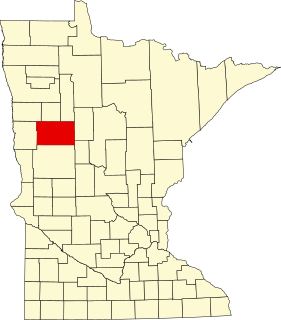
This is a list of the National Register of Historic Places listings in Becker County, Minnesota. It is intended to be a complete list of the properties and districts on the National Register of Historic Places in Becker County, Minnesota, United States. The locations of National Register properties and districts for which the latitude and longitude coordinates are included below may be seen in an online map.

This is a list of the National Register of Historic Places listings in Meeker County, Minnesota.
This is a list of the National Register of Historic Places listings in Voyageurs National Park.

The Sunset Beach Hotel, also referred to as Peters' Sunset Beach Resort, is a historic resort hotel in Glenwood Township, Pope County, Minnesota, 5 miles (8.0 km) southwest of Glenwood, United States. Situated on the southern shore of Lake Minnewaska, three structures of the private, commercial resort were placed on the National Register of Historic Places (NRHP) on February 11, 1982. The complex is notable because it stands as one of the best-preserved early resorts in west central Minnesota, and as a center of seasonal resort activity on the lake since the second decade of the twentieth century.
St. Columba Mission was an Ojibwe community on Gull Lake in Crow Wing County, Minnesota, United States, about 11 miles (18 km) north of Fort Ripley. It centered on the first Native American Christian church in the United States west of the Mississippi River, founded in 1852 by the Episcopal missionary James Lloyd Breck and Enmegahbowh, who served as deacon. The squared log church was consecrated in 1853 by Bishop Jackson Kemper.

Larson's Hunters Resort is a historic former hunting resort in Lake Valley Township, Minnesota, United States. It was in operation from the 1890s to the 1960s and became the best known hunting resort in Traverse County, while also being maintained as an active farm. Larson's Hunters Resort was listed on the National Register of Historic Places in 1985 for having local significance in the themes of architecture and commerce. As a historic district it consists of a prominent brick farmhouse/lodge built in 1901 and eight outbuildings. It was nominated for exemplifying the important hunting industry in west-central Minnesota and the phenomenon of farmer/resort owners, while the main building was further noted as the largest and most intact farmhouse in Traverse County, and one of the few constructed of brick.
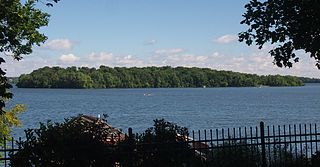
Coney Island of the West is an island in Lake Waconia in the U.S. state of Minnesota that was developed into a summer resort with its heyday from the 1880s to the 1920s. It continued operating up to 1960. The 31-acre (13 ha) island is part of Waconia Township just .5 miles (0.80 km) off the shore from the city of Waconia. It was listed on the National Register of Historic Places in 1976 for its local significance in the themes of commerce and entertainment/recreation. The island site, with its ruins of hotels, cottages, and parks, was nominated for being one of Minnesota's most popular early resorts, and an early expression of the trend of urban dwellers journeying to Minnesota's lakes and parks for recreation. Lambert Naegele, Reinhold Zeglin, and Emile Amblard developed resort buildings and attractions on the island. The best preserved building from this era, however, is the Emile Amblard Guest House on the mainland.

Fort Ripley was a United States Army outpost on the upper Mississippi River, in mid-central Minnesota from 1848 to 1877. It was situated a few miles from the Indian agencies for the Ho-Chunk and Ojibwe in Iowa Territory and then the Minnesota Territory. Its presence spurred immigration into the area and the pioneer settlement of Crow wing developed closeby. The post was initially named Fort Marcy. It then was renamed Fort Gaines and in 1850 was renamed again for distinguished Brigadier General Eleazer Wheelock Ripley of the War of 1812. It was the second major military reservation established in what would become Minnesota.

The Ottawa Beach Historic District is a residential historic district located on Ottawa Beach Road in Park Township, Ottawa County, Michigan near the outlet of Lake Macatawa. It was listed on the National Register of Historic Places in 1995.

SS Robert Wallace was a wooden-hulled American bulk freighter that served on the Great Lakes of North America from her construction in 1882 to her sinking in 1902 on Lake Superior near the town of Palmers, St. Louis County, Minnesota, United States. On November 17, 1902 shortly after leaving Superior, Wisconsin with a cargo of iron ore, Robert Wallace sprang a leak and sank. Her wreck was found in 2006, and on October 14, 2009, the wreck of Robert Wallace was listed in the National Register of Historic Places.

The Amboy was a wooden schooner barge that sank along with her towing steamer, the George Spencer on Lake Superior off the coast of Schroeder, Cook County, Minnesota in the United States. In 1994 the remains of the Amboy were added to the National Register of Historic Places.






















